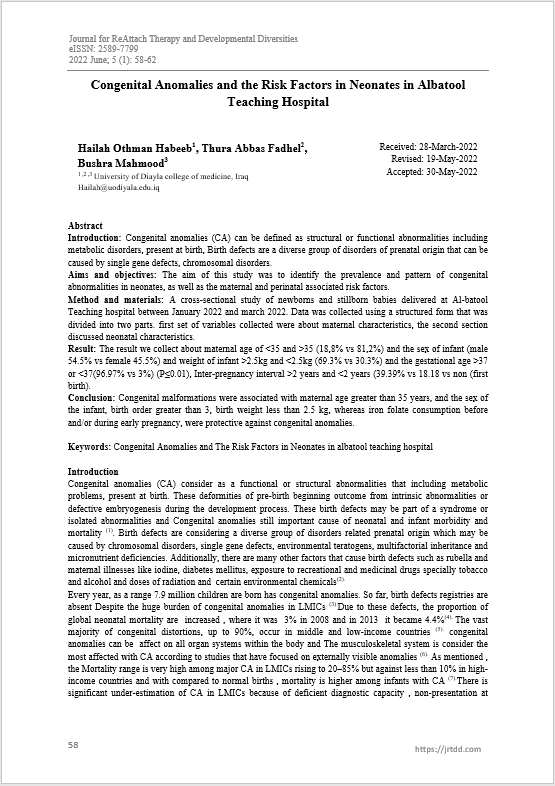Congenital Anomalies and the Risk Factors in Neonates in Albatool Teaching Hospital
Main Article Content
Abstract
Introduction: Congenital anomalies (CA) can be defined as structural or functional abnormalities including metabolic disorders, present at birth, Birth defects are a diverse group of disorders of prenatal origin that can be caused by single gene defects, chromosomal disorders.
Aims and objectives: The aim of this study was to identify the prevalence and pattern of congenital abnormalities in neonates, as well as the maternal and perinatal associated risk factors.
Method and materials: A cross-sectional study of newborns and stillborn babies delivered at Al-batool Teaching hospital between January 2022 and march 2022. Data was collected using a structured form that was divided into two parts. first set of variables collected were about maternal characteristics, the second section discussed neonatal characteristics.
Result: The result we collect about maternal age of <35 and >35 (18,8% vs 81,2%) and the sex of infant (male 54.5% vs female 45.5%) and weight of infant >2.5kg and <2.5kg (69.3% vs 30.3%) and the gestational age >37 or <37(96.97% vs 3%) (P≤0.01), Inter-pregnancy interval >2 years and <2 years (39.39% vs 18.18 vs non (first birth).
Conclusion: Congenital malformations were associated with maternal age greater than 35 years, and the sex of the infant, birth order greater than 3, birth weight less than 2.5 kg, whereas iron folate consumption before and/or during early pregnancy, were protective against congenital anomalies.
Article Details
References
Francine R, Pascale S, Aline H. Congenital anomalies: prevalence and risk factors. Univers J Public Health. 2014;2:58–63.
El Koumi, M. A., Al Banna, E. A., & Lebda, I. (2013). Pattern of congenital anomalies in newborn: a hospital-based study. Pediatric reports, 5(1), 20-23.
Ndibazza J, Lule S, Nampijja M, Mpairwe H, Oduru G, Kiggundu M, et al. A description of congenital anomalies among infants in Entebbe, Uganda. Birt Defects Res A Clin Mol Teratol. 2011;91:857–61.
Liu L, Oza S, Hogan D, Perin J, Rudan I, Lawn JE, et al. Global, regional, and national causes of child mortality in 2000–13, with projections to inform post-2015 priorities: an updated systematic analysis. Lancet. 2015;385:430–40.
Linda R. Musser. (2020). Older Engineering Books are Open Educational Resources. Journal of Online Engineering Education, 11(2), 08–10. Retrieved from http://onlineengineeringeducation.com/index.php/joee/article/view/41
Sitkin NA, Ozgediz D, Donkor P, Farmer DL. Congenital anomalies in low- and middle-income countries: the unborn child of global surgery. World J Surg. 2015;39:36–40.
Sarkar S, Patra C, Dasgupta MK, Nayek K, Karmakar PR. Prevalence of congenital anomalies in neonates and associated risk factors in a tertiary care hospital in eastern India. J Clin Neonatol. 2013;2:131.
Sachdeva S, Nanda S, Bhalla K, Sachdeva R. Gross congenital malformation at birth in a government hospital. Indian J Public Health. 2014;58:54.
Lawal TA, Yusuf B, Fatiregun AA. Knowledge of birth defects among nursing mothers in a developing country. Afr Health Sci. 2015;15:180–7.
Maleki, Z., Ghaem, H., Seif, M., & Foruhari, S. (2022). Incidence of and Maternal-fetal Risk Factors Associated with Therapeutic Abortion: A Nested Case-control Design Based on a Population-based Historical Cohort. Journal of Health Sciences & Surveillance System, 10(1), 71-77.
Mekonnen, D., & Worku, W. (2021). Congenital anomalies among newborn babies in Felege-Hiwot Comprehensive Specialized Referral Hospital, Bahir Dar, Ethiopia. Scientific Reports, 11(1), 1-8
Saleh, M. A. OUTCOMES OF TEENAGE PREGNANCY AT BENGHAZI MEDICAL CENTER 2019-2020. https://www.researchgate.net/profile/Mohanad-Lawgali/publication/359624113_OUTCOMES_OF_TEENAGE_PREGNANCY_AT_BENGHAZI_MEDICAL_CENTER_2019-2020_1/links/6245bdea7931cc7ccf07fea8/OUTCOMES-OF-TEENAGE-PREGNANCY-AT-BENGHAZI-MEDICAL-CENTER-2019-2020-1.pdf.
Abebe, S., Gebru, G., Amenu, D., Mekonnen, Z., & Dube, L. (2021). Risk factors associated with congenital anomalies among newborns in southwestern Ethiopia: A case-control study. PloS one, 16(1), e0245915.
Andrew Knight, Natalie Light. (2021). The Nutritional Soundness of Meat-Based and Plant-Based Pet Foods. Revista Electronica De Veterinaria, 01 - 21. Retrieved from https://www.veterinaria.org/index.php/REDVET/article/view/92
Karim Bouadil & Saïd El Madidi. Effect of consanguinity on birth weight and birth defects in the Agadir region of Morocco. World Journal of Biology Pharmacy and Health Sciences 2022, 9, 055–059.
Li, Z. Y., Chen, Y. M., Qiu, L. Q., Chen, D. Q., Hu, C. G., Xu, J. Y., & Zhang, X. H. (2019). Prevalence, types, and malformations in congenital anomalies of the kidney and urinary tract in newborns: a retrospective hospital-based study. Italian journal of pediatrics, 45(1), 1-7.
Tayebi N, Yazdani K, Naghshin N. The prevalence of congenital malformations and its correlation with consanguineous marriages. Oman medical journal. 2010; 25(1): 37.
Mekonnen, D., & Worku, W. (2021). Congenital anomalies among newborn babies in Felege-Hiwot Comprehensive Specialized Referral Hospital, Bahir Dar, Ethiopia. Scientific Reports, 11(1), 1-8.
Abebe, S., Gebru, G., Amenu, D., Mekonnen, Z., & Dube, L. (2021). Risk factors associated with congenital anomalies among newborns in southwestern Ethiopia: A case-control study. PloS one, 16(1), e0245915.
Rathod, S., & Samal, S. K. (2020). Prevalance and patterns of congenital anomalies in a tertiary care centre in Pondicherry. Drugs, 15, 10-71.
Karim, B. O. U. A. D. I. L., & Saïd, E. M. Congenital anomalies in neonates and associated risk factors in Agadir region of Morocco. Eye, 16, 19-75.
Shivanagappa, M., Kumarachar, S. H., Mahadevaiah, M., & Mahesh, M. (2019). Pattern of congenital anomalies and associated maternal risk factors: A study from Mysore, South India. Age, 20(25), 28.
Al-Assadi, A. F., Al-Haroon, D. S., Al-Rubaye, A., & Abdul-Rahman, B. A. (2018). Risk Factors and neonatal outcome among preterm birth at Basrah central hospitals. The Medical Journal of Basrah University, 36(2), 87-96.
Parikh, Y. N., Kalathia, M. B., & Soodhana, D. (2018). Clinical profile of congenital limb anomalies in neonates. Int J Contemp Pediatr, 5(2), 299.

